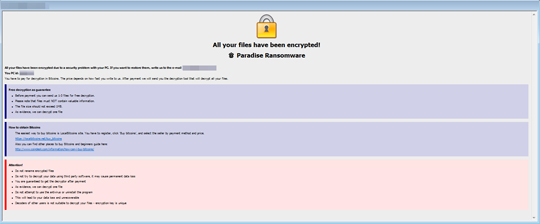Ransom.Win32.PARADISE.B
TR/AD.ParadiseRansom.DP (ANTIVIR); Trojan-Ransom.Win32.Instructions.ce (KASPERSKY)
Windows


Threat Type: Ransomware
Destructiveness: No
Encrypted: No
In the wild: Yes
OVERVIEW
Downloaded from the Internet
This Ransomware arrives on a system as a file dropped by other malware or as a file downloaded unknowingly by users when visiting malicious sites.
TECHNICAL DETAILS
107,008 bytes
EXE
UPX
Yes
22 Apr 2019
Connects to URLs/IPs, Encrypts files, Displays message/message boxes
Arrival Details
This Ransomware arrives on a system as a file dropped by other malware or as a file downloaded unknowingly by users when visiting malicious sites.
Installation
This Ransomware drops the following files:
- %Application Data%\parid.bin - contains unique code
(Note: %Application Data% is the current user's Application Data folder, which is usually C:\Documents and Settings\{user name}\Application Data on Windows 2000, XP, and Server 2003, or C:\Users\{user name}\AppData\Roaming on Windows Vista, 7, and 8.)
Autostart Technique
This Ransomware drops the following file(s) in the Windows User Startup folder to enable its automatic execution at every system startup:
- %User Startup%\{random characters}.hta
- %User Startup%\{random characters}.exe
(Note: %User Startup% is the current user's Startup folder, which is usually C:\Windows\Profiles\{user name}\Start Menu\Programs\Startup on Windows 98 and ME, C:\WINNT\Profiles\{user name}\Start Menu\Programs\Startup on Windows NT, C:\Documents and Settings\{User name}\Start Menu\Programs\Startup on Windows XP, or C:\Users\{user name}\AppData\Roaming\Microsoft\Windows\Start Menu\Programs\Startup on Windows Vista, 7, and 8.)
Process Termination
This Ransomware terminates processes or services that contain any of the following strings if found running in the affected system's memory:
- mysql
- IBM
- bes10
- black
- sql
- store.exe
- vee
- postg
- sage
- ShadowProtectSvc
- SPAdminV4
- SPTimerV4
- SPTraceV4
- SPUserCodeV4
- SPWriterV4
- SPSearch4
- firebirdguardiandefaultinstance
- Simply Accounting Database Connection Manager
- ibmiasrw
- QBPOSDBServiceV12
- QBCFMonitorService
- QBVSS
- mr2kserv
- WinDefend
- MSExchangeADTopology
- SQLWriter
- ReportServer$ISARS
- SQLBrowser
- IISADMIN
- IBM Domino Server (CProgramFilesIBMDominodata)
- MSExchangeSA
- MSExchangeIS
- IBM Domino Diagnostics (CProgramFilesIBMDomino)
- QuickBooksDB25
- QuickBooksDB24
- QuickBooksDB23
- QuickBooksDB22
- QuickBooksDB21
- QuickBooksDB20
- QuickBooksDB19
- QuickBooksDB18
- QuickBooksDB17
- QuickBooksDB16
- QuickBooksDB15
- QuickBooksDB14
- QuickBooksDB13
- QuickBooksDB12
- QuickBooksDB11
- QuickBooksDB10
- QuickBooksDB9
- QuickBooksDB8
- QuickBooksDB7
- QuickBooksDB6
- QuickBooksDB5
- QuickBooksDB4
- QuickBooksDB3
- QuickBooksDB2
- QuickBooksDB1
- MSExchangeFBA
- SQLAgent$MSFW
- SQLAgent$ISARS
- MSSQL$MSFW
- MSSQL$ISARS
- MSSQLServerADHelper100
Other Details
This Ransomware connects to the following URL(s) to get the affected system's IP address:
- iplogger.org
It does the following:
- It deletes all shadow copies using the following command:
- vssadmin delete shadows /all /quiet
- It displays the following window after encryption:

- It encrypts files which can be found in the following locations:
- Removable drives
- Fixed drives
- Remote drives
- It disables Windows Defender by modifying the following registry entry:
- In HKEY_LOCAL_MACHINE\SOFTWARE\Policies\Microsoft\Windows Defender
- DisableAntiSpyware = 1
- DisableAntiSpyware = 1
- In HKEY_LOCAL_MACHINE\SOFTWARE\Policies\Microsoft\Windows Defender
- It deletes and terminates itself if the language of the target machine is any of the following:
- Russian
- Kazakh
- Belarusian
- Ukrainian
- Tatar
Ransomware Routine
This Ransomware avoids encrypting files found in the following folders:
- Windows
- $Recycle bin
- System Volume Information
- Program Files
- Program Files (x86)
It renames encrypted files using the following names:
- {file name}.{file extension}_{unique code}_{petrus34@p-security.li}.sambo
It leaves text files that serve as ransom notes containing the following text:
- {Encrypted Directory}\Instructions with your files.txt

SOLUTION
9.850
14.954.04
22 Apr 2019
14.955.00
23 Apr 2019
Step 1
Before doing any scans, Windows 7, Windows 8, Windows 8.1, and Windows 10 users must disable System Restore to allow full scanning of their computers.
Step 2
Note that not all files, folders, and registry keys and entries are installed on your computer during this malware's/spyware's/grayware's execution. This may be due to incomplete installation or other operating system conditions. If you do not find the same files/folders/registry information, please proceed to the next step.
Step 3
Identify and terminate files detected as Ransom.Win32.PARADISE.B
- Windows Task Manager may not display all running processes. In this case, please use a third-party process viewer, preferably Process Explorer, to terminate the malware/grayware/spyware file. You may download the said tool here.
- If the detected file is displayed in either Windows Task Manager or Process Explorer but you cannot delete it, restart your computer in safe mode. To do this, refer to this link for the complete steps.
- If the detected file is not displayed in either Windows Task Manager or Process Explorer, continue doing the next steps.
Step 4
Restore this modified registry value
Important: Editing the Windows Registry incorrectly can lead to irreversible system malfunction. Please do this step only if you know how or you can ask assistance from your system administrator. Else, check this Microsoft article first before modifying your computer's registry.
- In HKEY_LOCAL_MACHINE\SOFTWARE\Policies\Microsoft\Windows Defender
- DisableAntiSpyware = 0
- DisableAntiSpyware = 0
Step 5
Search and delete this file
- %Application Data%\parid.bin
- %User Startup%\{random characters}.hta
- %User Startup%\{random characters}.exe
- {Encrypted Directory}\Instructions with your files.txt
Step 6
Scan your computer with your Trend Micro product to delete files detected as Ransom.Win32.PARADISE.B. If the detected files have already been cleaned, deleted, or quarantined by your Trend Micro product, no further step is required. You may opt to simply delete the quarantined files. Please check the following Trend Micro Support pages for more information:
Step 7
Restore encrypted files from backup.
NOTES:
Enabling Volume Shadow Service
- Run the command prompt (cmd.exe) as administrator.
- Enable Volume Shadow Service using the following command:
net start vss
Did this description help? Tell us how we did.

